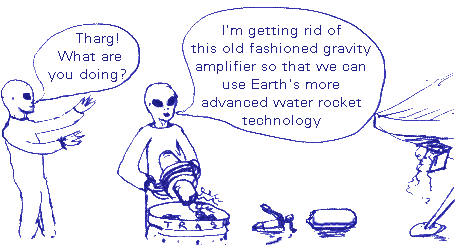This site is intended to provide a basis upon which a
newcomer to water rocketry (hobbyist, student,
teacher/lecturer) can familiarise him/herself with the
amount of thrust available, building up the required
experience and enjoyment without falling It is based on I have chosen a light coloured background so that printing out takes less ink and I have tended to put things on one page (such as the design of a particular rocket, putting pictures of it on another page) because I know that if I tried to get it so that it printed out in whole pages, there would always be that single line at the bottom that takes an extra sheet for some reason and it is better that this only happens once. I have now got around to building a launcher of my own and you can also look at this design - feel free to build one of your own and don't hesitate to let me know of any tips or problems. Apart from this site, there are a number of others that provide the information required to progress from not believing that a pop bottle can fly, through first flights (all covered on this site) to multi-stage rockets and so on. There is also an e-mail discussion group that you can join on http://www.h2orocket.com/topic/newsletter/email.html or http://www.osa.com.au/~cjh/rockets/list.html . This is the AWARS international discussion group and there are many people in it who have a great deal of experience and can usually offer some good advice if not actually solve your problem (sometimes, we even agree on things). Before you build or
launch anything, read through Even though that with an ordinary bicycle pump, you can never get as high a pressure as you can get in a supermarket pop bottle, you should still Play Safe. This part of the site has become a little larger than I had originally anticipated. If you have been here before and just want to see what is new then have a look at the What's New page. |
|||||
|
 the principle that
experimentation should be as inexpensive as possible (unless
you do something spectacularly stupid of course) and
use parts that either are available worldwide or have
equivalents worldwide. In addition, anybody should be
able to take part and therefore no special engineering
should be necessary in order to manufacture any of the
parts required - you should be able to make a water
rocket whether you have access to a large, well equiped
workshop or live in a high-rise tower block (although
I recommend that you do not do any launching from
buildings). No special knowledge is required as
computer modelling can be done with a PC or using one of
the online models (using the figures given here as a
guide, you don't even have to do any computer modelling).
In short, if you can use a bicycle pump, use a knife
without cutting yourself and use a browser, you should be
able to launch a water rocket.
the principle that
experimentation should be as inexpensive as possible (unless
you do something spectacularly stupid of course) and
use parts that either are available worldwide or have
equivalents worldwide. In addition, anybody should be
able to take part and therefore no special engineering
should be necessary in order to manufacture any of the
parts required - you should be able to make a water
rocket whether you have access to a large, well equiped
workshop or live in a high-rise tower block (although
I recommend that you do not do any launching from
buildings). No special knowledge is required as
computer modelling can be done with a PC or using one of
the online models (using the figures given here as a
guide, you don't even have to do any computer modelling).
In short, if you can use a bicycle pump, use a knife
without cutting yourself and use a browser, you should be
able to launch a water rocket. 